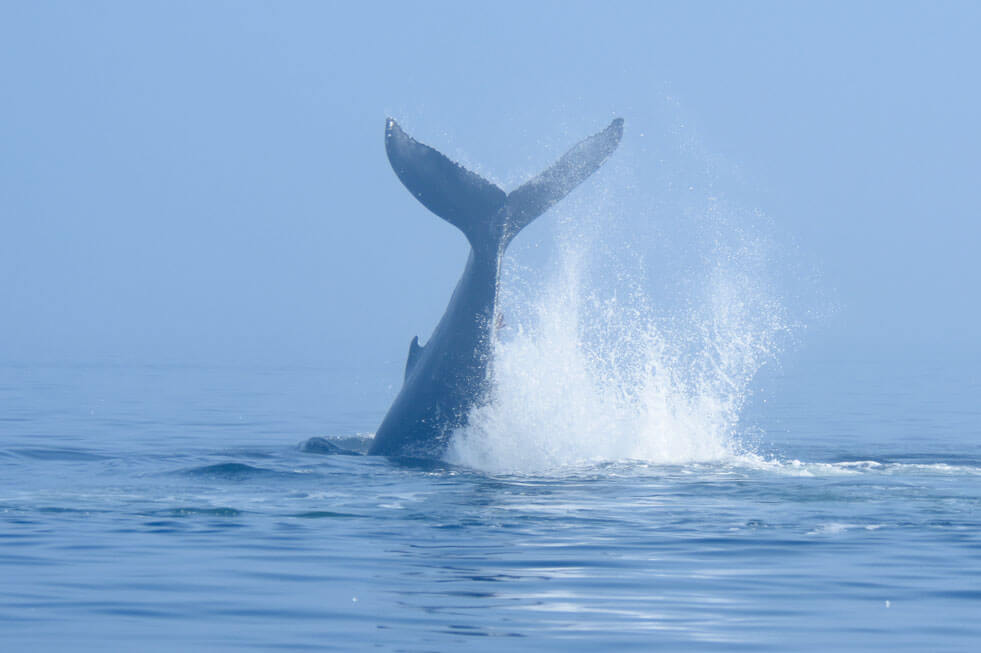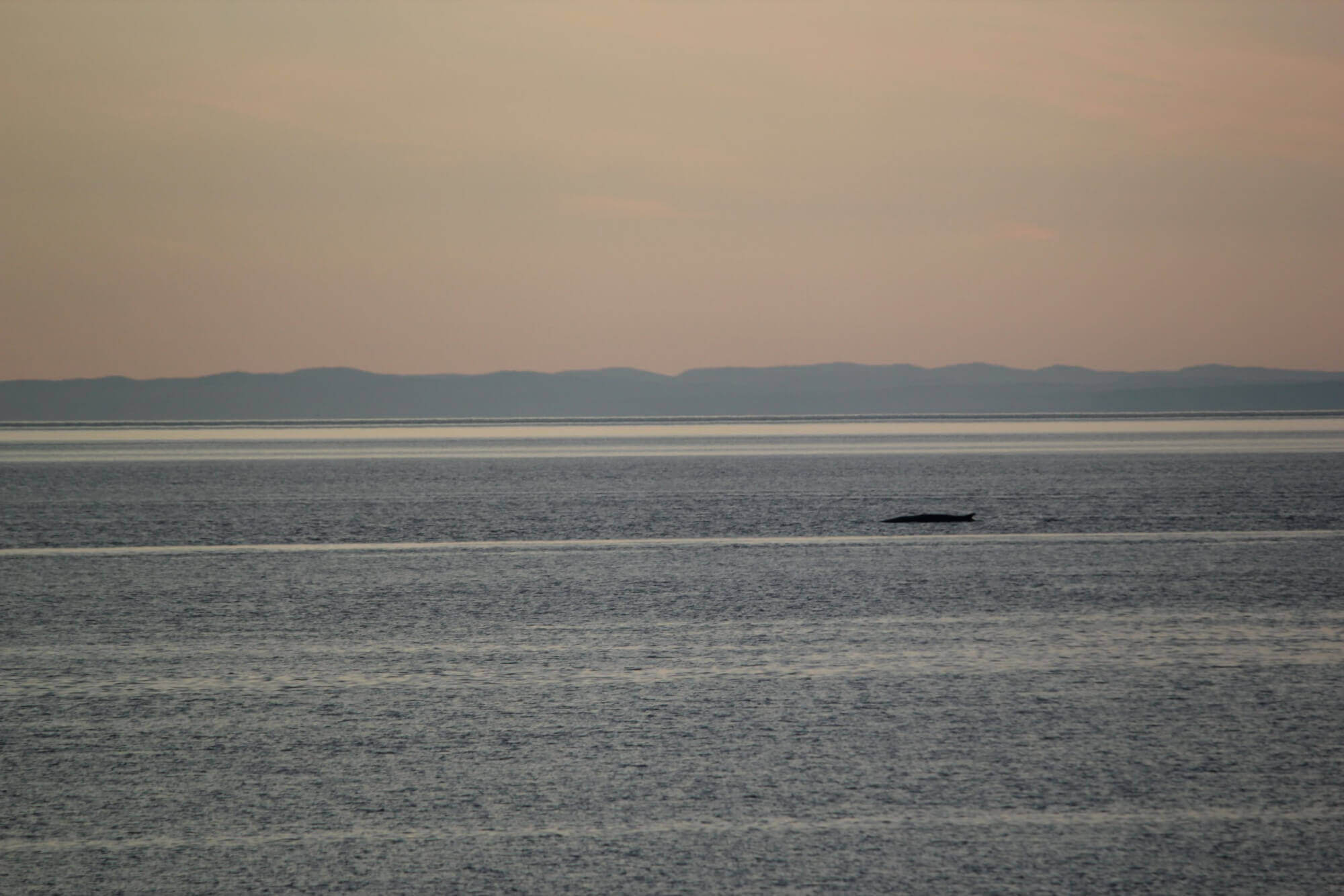As I’m driving down Highway 132, my eye is suddenly drawn out to sea. From the dark, rolling water spews a large balloon-shaped spout, then two, then three. Then a tail. “A tail?!” I pull over to the side of the road near Saint-Maurice-de-l’Échouerie to scan the horizon. As the wind howls and the swell surges, a dozen or so humpback whales are having a field day, breaching in the waves or poking their pectoral fins out of the water in a graceful salute. From shore, a black and white tail can clearly be seen rising high in the sky before slamming down on the surface.
The whale repeats this splashing manoeuvre for about 10 minutes. Known as “lobtailing”, this behaviour remains quite the enigma. Like breaching, it is more frequently observed in rough weather and seems to be linked to social activities. Are they games, threats, a way to amplify communication when the wind and waves tend to mask vocalizations, or even a little trick to get rid of parasites by “scratching” oneself in the raging waves? Who knows… but what a spectacle!
A horizontal, mostly cartilaginous appendage, the caudal fin of whales is a remarkably efficient tool for moving under water, so much so that it is inspiring researchers in their efforts to enhance the propulsion of large ships. But for observers on the St. Lawrence, a whale’s tail is always a precious and moving sight, and sometimes a most useful element to identify a species, an individual or a behaviour.
Return of Tic Tac Toe
On June 11, our collaborator Renaud Pintiaux photographed the tail of a humpback whale off the coast of Tadoussac. The large cross on the right lobe of the animal’s caudal fin leaves no room for doubt: it’s Tic Tac Toe! Like all humpbacks, Tic Tac Toe frequently raises her tail when she dives, revealing a colour pattern that is unique to her and allows her to be identified, much like a fingerprint. Researchers can thus compile observations of the same whale, understand its movements, know its history and the frequency of its visits, etc. For the photographer, seeing the emblematic Tic Tac Toe, a regular visitor to the Marine Park since 1999, is above all an emotional experience, which he shares in these “Field Notes” published in Whales Online.
In the Saguenay-St. Lawrence Marine Park, observations of belugas are on the rise. Besides Tic Tac Toe and the young whale at her side (perhaps a new calf from our fertile matriarch?), a cruise captain tallies four humpbacks on his outing on June 12. On the morning of June 15, observers stationed at Cap de Bon-Désir had the chance to film a humpback raising its tail just as it was about to take a dive. Unfortunately, given the angle from which the footage was shot, the individual could not be identified.
At least four fin whales were also seen in these waters on June 13, including another star: Ti-Croche. This time, it was the shape of the animal’s dorsal fin and its colour patterns that facilitated the identification. Impossible to rely on the tail for this species, as it is rarely raised during dives.
And yet, sometimes this does happen! An avid birder and whale enthusiast working at Forillon National Park had the incredible surprise of observing 12 humpbacks, 8 fin whales and 7 or 8 minke whales from the Cap Gaspé lighthouse on the morning of June 11 and managed to film what appears to be a fin whale showing its tail! Even if the phenomenon is rare, it has on occasion been documented, in particular in deformed or maimed individuals (article in French). In this case, it appears to be a small fin whale. Perhaps its buoyancy isn’t as good as that of an adult and it needs a little flick of the tail to dive?
Big blasts along the coast
Migration is in full swing along the Gaspé coast. Not a day goes by without local residents being amazed by large spouts off the coast.
On June 12, near Grande-Vallée, 7 or 8 humpbacks are seen blowing in the dark waters of the St. Lawrence. (VIDEO) “Magical moments!” exclaims the observer. Around mid-day on June 13, a whale paid a brief visit to a resident in Cloridorme. “A little blast in front of the house, then nothing. And then another observation at supper time.” The same day, an observer posted at Pointe-Jaune noted the passage of two humpbacks and one fin whale in the midst of large gatherings of birds feasting on schools of fish. On June 15, a large column-shape blast was spotted in the Bay of Saint-Yvon. Could it be a blue whale already? In this giant of the seas, showing the tail before dives seems to vary widely from one population to another and from one individual to another. For example, it is estimated that 14 to 18% of the blue whales visiting the St. Lawrence lift their tails, some of them systematically. A study conducted in Sri Lanka, on the other hand, mentions a figure of 55% for the percentage of whales that exhibit this behaviour.
In the Mingan Islands, amateur cetologist Jacques Gélineau reports a humpback whale, “as well as a minke whale so big that it was almost mistaken for a fin!” Last Saturday, a passenger on board the ferry departing Baie-Comeau en route to Matane saw a humpback whale swimming toward Godbout. Is this the same individual that, two days later, was there to greet a Godbout resident in the early hours of the morning? “What a surprise it was to wake up, look out the window and see this huge rorqual in front of my house, after more than a year of waiting,” he exclaims.
What about belugas?!
All week long, the waters around Rivière-du-Loup and Île aux Lièvres have been churning with hundreds of white, grey and bluish backs. Near the Rivière-du-Loup wharf, mothers with young in tow come within 100 metres of the beach in search of small fish. Off the coast of Cacouna, mothers and calves have also been socializing quite a bit, sometimes crossing paths with minke whales. No belugas to report in Kamouraska, but rather good numbers of harbour seals drying themselves on the rocks. On June 11, from the ferry between Saint-Siméon and Rivière-du-Loup, a group of frolicking belugas are observed in the distance. Backs, heads and fins criss-cross in the billowing water. A white tail rises straight into the air.
A strange-looking animal was observed near Cacouna by two observers from the Marine Mammal
Observation Network (MMON) on June 9 and 11. A cetacean resembling a black toothed whale with a melon. The animal has been sighted twice offshore, breaching and apparently alone. We hope that future observations will be forwarded to us so that we might identify this astonishing individual.








